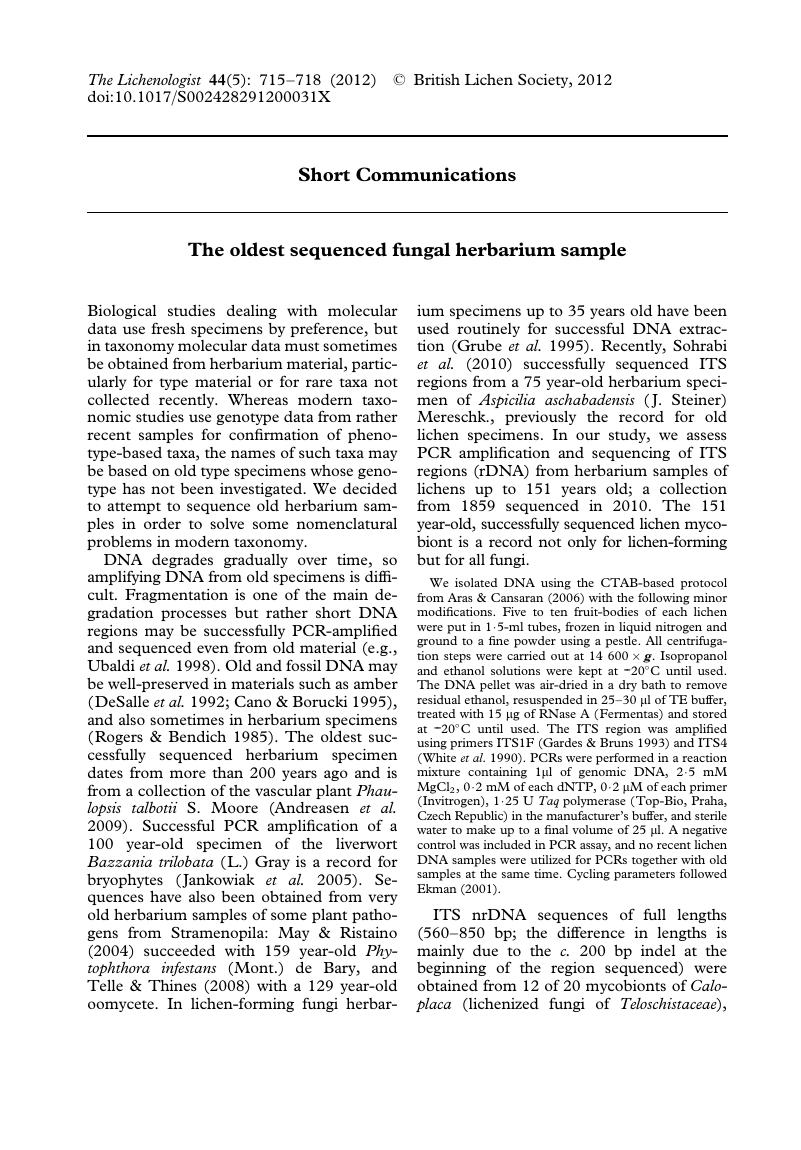Crossref Citations
This article has been cited by the following publications. This list is generated based on data provided by Crossref.
Hodkinson, Brendan P.
and
Hodkinson, Sarah Z.
2013.
Recent literature on lichens—228.
The Bryologist,
Vol. 116,
Issue. 1,
p.
89.
HAWKSWORTH, David L.
2013.
The oldest sequenced fungal specimen.
The Lichenologist,
Vol. 45,
Issue. 1,
p.
131.
Gueidan, Cécile
Aptroot, André
Cáceres, Marcela Eugenia da Silva
and
Binh, Nguyen Quoc
2016.
Molecular phylogeny of the tropical lichen family Pyrenulaceae: contribution from dried herbarium specimens and FTA card samples.
Mycological Progress,
Vol. 15,
Issue. 1,
Motiejūnaitė, Jurga
Chesnokov, Sergei V.
Czarnota, Paweł
Gagarina, Ludmila V.
Frolov, Ivan
Himelbrant, Dmitry
Konoreva, Ludmila A.
Kubiak, Dariusz
Kukwa, Martin
Moisejevs, Rolands
Stepanchikova, Irina
Suija, Ave
Tagirdzhanova, Gulnara
Thell, Arne
and
Tsurykau, Andrei
2016.
Ninety-One Species of Lichens and Allied Fungi New to Latvia with a List of Additional Records from Kurzeme.
Herzogia,
Vol. 29,
Issue. 1,
p.
143.
VONDRÁK, Jan
FROLOV, Ivan
DAVYDOV, Evgeny A.
URBANAVICHENE, Irina
CHESNOKOV, Sergey
ZHDANOV, Ilya
MUCHNIK, Evgenia
KONOREVA, Ludmila
HIMELBRANT, Dimitry
and
TCHABANENKO, Svetlana
2016.
The extensive geographical range of several species ofTeloschistaceae: evidence from Russia.
The Lichenologist,
Vol. 48,
Issue. 3,
p.
171.
Kruse, Julia
Choi, Young-Joon
and
Thines, Marco
2017.
New smut-specific primers for the ITS barcoding of Ustilaginomycotina.
Mycological Progress,
Vol. 16,
Issue. 3,
p.
213.
Forin, Niccolò
Nigris, Sebastiano
Voyron, Samuele
Girlanda, Mariangela
Vizzini, Alfredo
Casadoro, Giorgio
and
Baldan, Barbara
2018.
Next Generation Sequencing of Ancient Fungal Specimens: The Case of the Saccardo Mycological Herbarium.
Frontiers in Ecology and Evolution,
Vol. 6,
Issue. ,
Leavitt, Steven D.
Keuler, Rachel
Newberry, Clayton C.
Rosentreter, Roger
and
Clair, Larry L. St.
2019.
Shotgun sequencing decades-old lichen specimens to resolve phylogenomic placement of type material.
Plant and Fungal Systematics,
Vol. 64,
Issue. 2,
p.
237.
Lücking, Robert
Kaminsky, Laurel
Perlmutter, Gary B.
Lawrey, James D.
and
Forno, Manuela Dal
2020.
Cora timucua (Hygrophoraceae), a new and potentially extinct, previously misidentified basidiolichen of Florida inland scrub documented from historical collections.
The Bryologist,
Vol. 123,
Issue. 4,
Lücking, Robert
2021.
Peter D. Crittenden: meta-analysis of an exceptional two-decade tenure as senior editor of The Lichenologist, the flagship journal of lichenology.
The Lichenologist,
Vol. 53,
Issue. 1,
p.
3.
Frolov, Ivan
Vondrák, Jan
Košnar, Jiří
and
Arup, Ulf
2021.
Phylogenetic relationships withinPyrenodesmiasensu lato and the role of pigments in its taxonomic interpretation.
Journal of Systematics and Evolution,
Vol. 59,
Issue. 3,
p.
454.
Gómez-Zapata, Paula Andrea
Haelewaters, Danny
Quijada, Luis
Pfister, Donald H.
and
Aime, M. Catherine
2021.
Notes on Trochila (Ascomycota, Leotiomycetes), with new species and combinations.
MycoKeys,
Vol. 78,
Issue. ,
p.
21.
Dal Forno, Manuela
Lawrey, James D.
Moncada, Bibiana
Bungartz, Frank
Grube, Martin
Schuettpelz, Eric
and
Lücking, Robert
2022.
DNA Barcoding of Fresh and Historical Collections of Lichen-Forming Basidiomycetes in the Genera Cora and Corella (Agaricales: Hygrophoraceae): A Success Story?.
Diversity,
Vol. 14,
Issue. 4,
p.
284.
Gueidan, Cécile
and
Li, Lan
2022.
A long-read amplicon approach to scaling up the metabarcoding of lichen herbarium specimens.
MycoKeys,
Vol. 86,
Issue. ,
p.
195.
Bradshaw, Michael J.
Carey, Julie
Liu, Miao
Bartholomew, Holly P.
Jurick, Wayne M.
Hambleton, Sarah
Hendricks, Dylan
Schnittler, Martin
and
Scholler, Markus
2023.
Genetic time traveling: sequencing old herbarium specimens, including the oldest herbarium specimen sequenced from kingdom Fungi, reveals the population structure of an agriculturally significant rust.
New Phytologist,
Vol. 237,
Issue. 4,
p.
1463.



